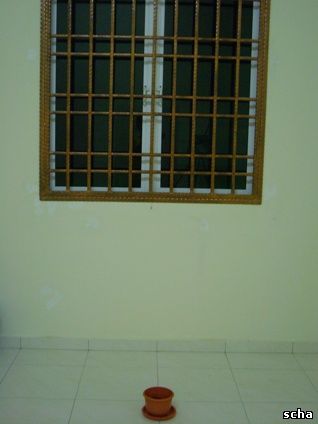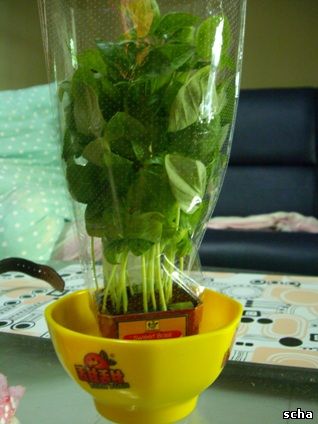| Main » Articles » Articles » Gardens & Plants |
Indoor Basil Care - How Not to Kill It
Little can be done when it comes to infections, diseases, and pests towards our basil plants. Therefore, prevention is the key. Seeds  Picture above is an example of basil seeds that you can find around in gardening stores. I haven't yet so far planted basil from seeds, so I will share its growth here. If you bought the plant already grown in a pot, you can skip this part. The instructions written behind the package are simple ones. They are the usual guides you can find if you search using Google.  Day 1 after planting the seeds. A suitable weather for growing basil is summer. Therefore, in a place like Malaysia, growing basil is not a problem. This herb is highly adaptable to acidic and alkaline soils. So it can be grown on almost any type of soils. I chose fertilized organic compost soil. Make sure the soil is well-drained, and remove any excessive water that puddles up on the tray underneath the pot. Using your fingertip, dip into the soil to check whether the soil is moist. Too dry or too watery soil is not right. When you think it's ready, pour the seeds on the surface of the soil. The seeds need to grow under good air circulation, so there's no need to cover them with thick soil. Pour just some thin layer of soil on top.  The spot where I place my basil pot. Place the pot where it can get sunlight, for example at the window sill. But not too much sun. Direct sunlight is not the right choice for basil. You can also place it outside once in a while just for it to get some fresh air. Do not place your basil pot too close to other vegetables or fruits, plants, or the ones you just bought from the store. Happened to me that my basil plant died from a fungal infection that was spread from my onions.  Day 2. The seeds start creating thin transparent layers, almost like bubbles. Check everyday for the moist. There's no need to water everyday. Just make sure the soil is damp. Wait for around 5 to 10 days for the seedlings to grow.  Day 4. Seedlings appearing.  Day 5. As the seedlings grow, watch for the amount of sunlight. Seedlings need a lot of sun. If you notice the stems are getting too long, place the pot where it can get more sun. It's alright if you can't find any. Just have to make sure the seedlings get enough moist from the soil. Don't let the soil become too dry.  Day 6. The stems grow even overnight. As soon as you notice a new pair of leaves grown on a stem, remove the plant into another pot. I would suggest the smallest pots possible that you can find, with holes underneath for drainage of water. And then, you can start taking care of it as a plant, no longer a seedling. Early Stage  My sweet basil plant that I bought originally like the picture itself. Since the last one died (uncontrollable fungal infection), I bought a new set of sweet basil plants from the store. I haven't yet separated them, which I'll do so after I'm done with the seedlings before. Sweet basil is more fragile than Genovese basil (the seedlings), but the aroma is the best than others. I have tried a few leaves inside pasta, it turned out more delicious than ever. However, you have to take care of it just like another basil plant, but of course, with extra care. When we talk about aroma, you can imagine how many insects will be jumping from one of the leaves to another, and probably also munching off some. Water only on the plate, which means on the bottom of the pot. The roots need water, not the stems or the leaves.  The roots at the bottom coming out seeking water from the plate or in my case, the yellow bowl. Don't wet the leaves or the stems. It will lead to fungal infection. Sometimes fungus can live even inside the surface of the soil. This can rot the roots, and wilt the whole plant in such a short time. Common fungal diseases are fusarium wilt, gray mold, and black spot.
 Fungus attacked from the lower part of the stem, causing the leaves to wilt one by one.  My old basil plant infected by fungus with visible black marks everywhere. The fungus could also attack the seedlings, especially if the seeds are already infected with it. With warm weather and humidity, fungus can spread very easily. It's not very easy to reverse the effects done by fungus. Although it is not recommended, in case of urgency, you can try using fungicides. I made some homemade fungicides before, but didn't work. Insects and pests are very attracted to the aroma.
 The cuts on the leaves indicate there are insects around feeding on them. Insecticides and pesticides are easy to be found. But make sure you wash the leaves properly after harvesting. I would suggest sticky papers around the pot or the plastic bag with tiny holes as shown in the picture above for insects control. There are also some ways to make your own insecticides at home. If you want your basil plant to grow more leaves, you have to cut off some leaves to enhance the growth of a new pair of leaves. Basil grows very fast. Cutting off some leaves wont cause the plant to not growing anymore. Harvest  Isn't it wonderful that you can already pluck some leaves from your basil plant to add into your cooking? Fresh basil leaves smell really good, and trust me, you can't compare it with the dried ground ones. If it happens that your plant are bushy, I would suggest you to take the leaves from lower part, where the leaves are stacking together. Reducing the amount of leaves there may also reduce the chances of pests or insects to hide. Less moist will be trapped there, which means less risk of fungal diseases. So, you see, taking care of basil plants is not such a tricky task. It only takes some effort and attention, and also knowledge. You might fail (like me) in the beginning, but after several practice, it's really worth it. | |
| Views: 2500 | Rating: 0.0/0 |
| Total comments: 0 | |












